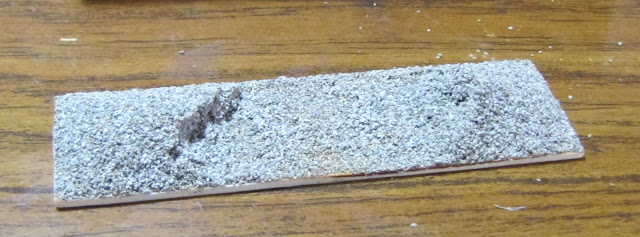 |
| SP 12070, one of the W-50-3 class Hart Ballast (work) cars that SP owned. |
I'll mention first off the bat is that Dry Creek Models has made some limited 3d prints for these cars. Robert Bowdidge discusses the history of various models of these cars on his blog: Comparing 3d Printed Models Against Kits of the Past.
The Original Kitbash
I suppose I should talk briefly about the kitbashing that I did to these cars to make them 'more accurate', although there are serious issues with the models that make them cheap stand-ins at best. My original work on these models was done in the early-2000s.
These cars should be more properly called "Work Cars" because they were not limited to only dumping ballast. Originally, the prototypes for these cars had side-doors and were convertible to have a flat bottom and drop ends. A wedge could be pulled through on a wench (which occupied an entire car!) and successive gondolas could be unloaded with the plow pushing the dirt out the sides of these cars.
 |
| Interior of TM/Walthers SP W-50-3 class "Work Car" - 2004 |
In their ballasting configuration, these cars have Hart-type drop doors down the center line, which are revealed when the cover panels are lifted up and outward on hinges to form longitudinal slope sheets. This made the car completely self clearing. The end panels were movable from the end of the car inward to for the ends of the ballast compartment over the bolsters.
In the later years, these cars had their side doors fixed closed or replaced entirely with solid sides. Some cars even had steel side sheets installed! The cars with fixed sides had grab irons installed, as the molded-on ones are for the TM/Walthers model.
 |
| Modifications to the underside of the TM/Walthers model. - 2004 |
The photo above is from 2004 showing the moved centersill trusses moved in-board and the K-brake moved out to the sidesill of the car. A new Tichy staff brake mechanism, staff and brakewheel has been installed.
The remaining problem is that the sides are 5-boards high, and should be MUCH lower with only 3 boards (about 36" high). This would require cutting out the center portion of the sides all the way around. This could be done with a saw, but I've not decided to try it .... yet. I have several more bodies, so I might at some point in the future.
The Current Problem
In the early 2000's I'd made ballast loads for the three cars that I kitbashed. I noticed during my last trip to San Diego that one of them was damaged. It seems the ballast wasn't glued as well as it should have been.
 |
| Ballast Load damage - 2018 |
The center section of this load completely failed and broke away from the plastic sub-sheet which I made to match the interior of the car body. I elected to fashion a 'patch' of ballast to fill in the missing center section of ballast in the load. Once the ballast was formed into the 'right' shape that I liked, I coated the load with 'wet' water (water with a drop of liquid soap, or isopropal alcohol) which wets the loose ballast without disturbing it. Then 50% white glue-water mix was applied to fully saturate the load this time. After all, I don't want this to fail again!
Adding Spilled Ballast
On these cars I'm sure there was also a tendency to have ballast or dirt spill onto the deck at the ends of the car, when the end panels were positioned over the bolsters.
 |
| Here the white glue is added to the A-end of the car. Notice the shadows from the main load damage. |
Once the glue is down, like in so many pre-school projects, the glitter..... errr, I mean ballast! is added.
 |
| Ballast has been added to the A-end and some 'wet' water added to help the shapes look natural. |
Unlike so many 'glue craft' projects, I added the 'wet' water to break the surface tension of the glue and pull the ballast down into a realistic form.
 |
| The ballast around the B-end of the car. |
The ballast would tend to spread out the longer and farther the cars were pulled, eventually falling out the open end of the car, so I kept any 'piling' back close to the end panel of the ballast compartment.
Finishing Up
 |
| Here's the finished SP 12070 being switched at Caliente by the SP 2850. |
 |
| A reverse view of the SP 12070 at Caliente behind SP 2850. |
During the 'clean up' phase I broke off single pieces of ballast that somehow decided to stick to the vertical sides of the car body, and anything else that wasn't 'realistic'.
Jason Hill
Related Articles:
Ex-EPSW 40ft Ballast Car - Kitbashing an old Mantua gondola into a prototype model
Athearn 65ft Mill Gondolas (SP and other RRs) - Prototype history and weathering
A Trip Over Tehacahpi on Santa Fe's SCX-BI - Ride on a 3rd Class freight over one of the largest prototype operating model railroads in the country.
Busy Times in Bakersfield (Part 2) - SP Yard Overview - An in depth look at modeling a prototype division point yard during the 1950s.
Triple Trouble on Tehachapi - A Weird Day on the Hill - Bending the rules... the railroad way!

No comments:
Post a Comment
Please identify yourself at the end of your message. Please keep comments relevant to the post or questions to me directly.
All comments are moderated and must be approved, so give me a bit of time to approve them.
No random solicitation in comments. Spamming and phishing comments will be deleted or not allowed to post.